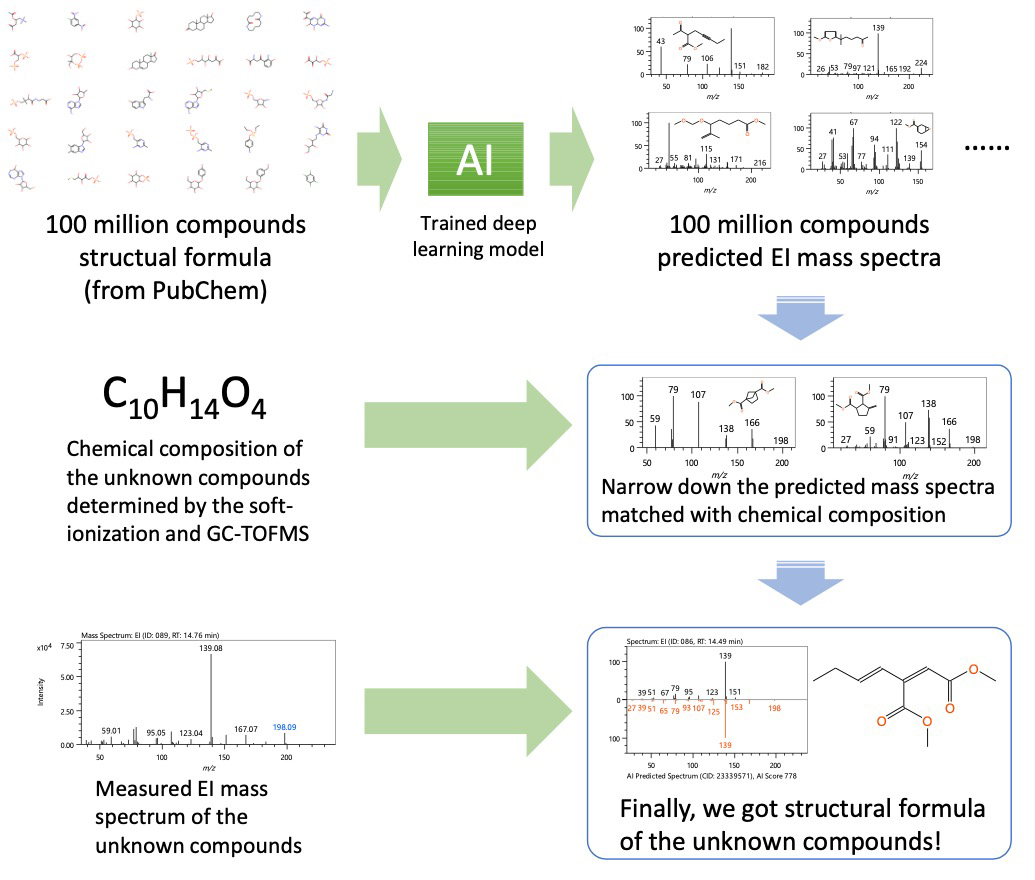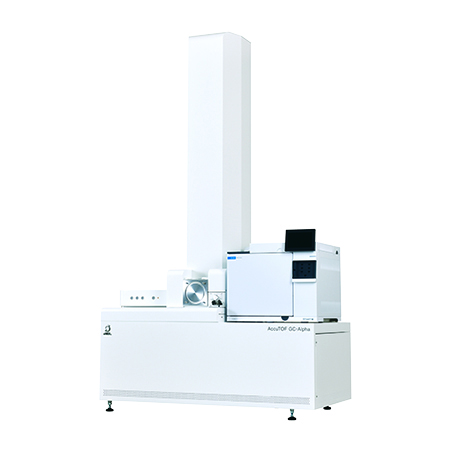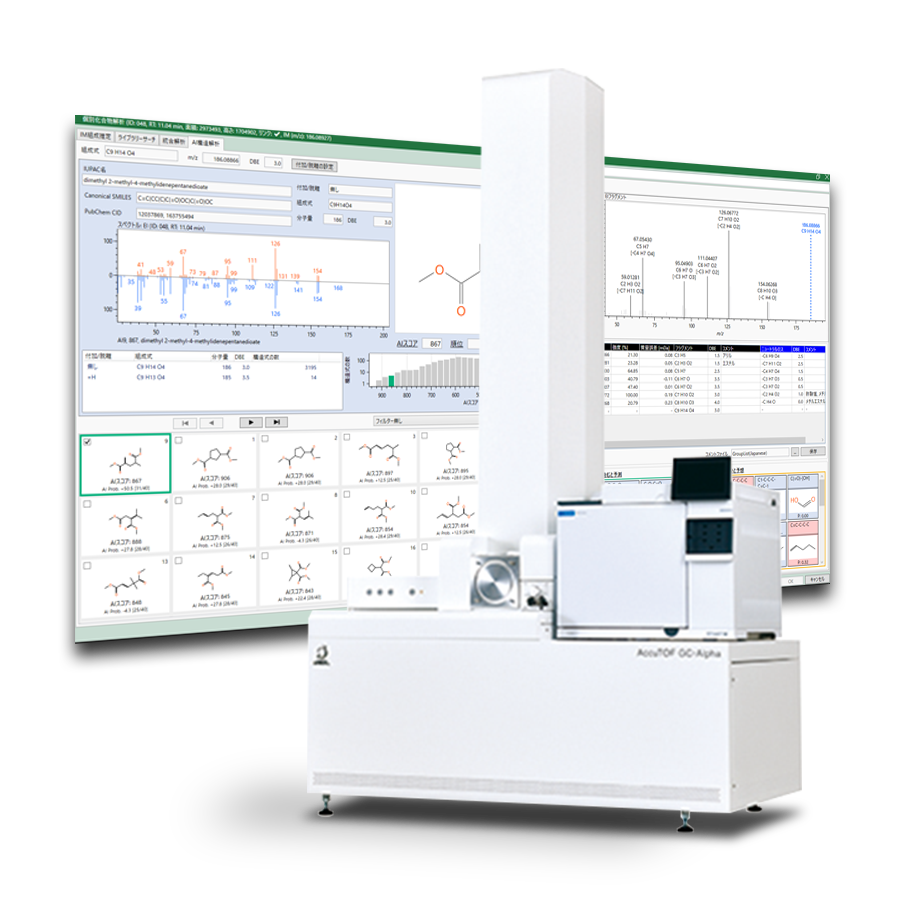Structural Analysis of Additives and Related Compounds in Vinyl Acetate by using a Py-GC-HRTOFMS and msFineAnalysis AI
MSTips No. 390
Introduction
Electron ionization (EI) is one of the most popular ionization methods used in gas chromatography-mass spectrometry (GC-MS). Consequently, compounds are typically identified by a mass spectral database search using EI mass spectra. Because molecular ions are often weak or absent in 70 eV EI mass spectra, identification of unknowns can be difficult by EI alone. In these cases, soft ionization (SI) can be very helpful for producing and identifying molecular ions. Recently, JEOL began developing an integrated qualitative analysis workflow that automatically combines and interprets the information from EI and SI data. And then in 2018, we introduced our integrated qualitative analysis software "msFineAnalysis" which uses both EI and SI data to improve compound identification for GC-MS applications.
Despite the fact that msFineAnalysis was automatically able to determine the molecular formula and partial structure information from EI fragment ion formulas, the actual structural formulas still required manual analysis using chemical compositions. To address this, we then developed an automated structure analysis software package entitled "msFineAnalysis AI" which uses artificial intelligence (AI) to predict EI mass spectra from chemical structures. We have used our newly-developed AI model to create a database of predicted EI mass spectra for around 100 million compounds. In this work, we introduce a polymer materials application that uses msFineAnalysis AI for structural analysis.
AI Structural Analysis

Figure 1: Workflow for structural analysis of unknowns using msFineAnalysis
The AI structural analysis workflow is shown in Figure 1. In this method, we used deep learning to construct an AI model that can predict the EI mass spectrum from a structural formula. We then submitted approximately 100 million compound structure formulas to our AI model in order to generate predicted EI mass spectra. The structural formula and the predicted EI mass spectra associated with each compound are included with the software as an "AI library" database that also includes database search function based on the mass spectral pattern. Additionally, msFineAnalysis AI uses the molecular formulas uniquely determined during automatic integrated qualitative analysis in order to narrow down the possible candidate structural formulas.
The predicted EI mass spectrum narrowed down by molecular formula and the actual EI mass spectrum are used to then calculate a score from the similarity of their spectral pattern, and the candidate structural formulas are then listed in order of high similarity to low similarity.
Experimental
A commercially-available vinyl acetate resin was used as a test sample in this study. We performed Py-GC-HRTOFMS measurements using both EI and field ionization (FI) modes with a combination EI/FI ion source. The qualitative data processing was performed with msFineAnalysis AI (JEOL). Measurement conditions are shown in Table 1.
Table 1: Measurement and analysis conditions
| Pyrolysis Conditions | |
|---|---|
| Pyrolyzer | EGA/PY-2020D (Frontier Lab) |
| Pyrolysis Temperature | 600°C |
| GC Conditions | |
| Gas Chromatograph | 7890 GC |
| (Agilent Technologies) | |
| Column | DB-5msUI (Agilent) |
| 15 m × 0.25 mm, 0.25 μm | |
| Oven Temperature | 50°C (1 min) - 30°C/min |
| -330°C (1.7 min) | |
| Injection Mode | Split mode (100:1) |
| Carrier flow | He: 1.5 mL/min |
| MS Conditions | |
|---|---|
| Spectrometer | JMS-T200GC (JEOL Ltd.) |
| Ion Source | EI/FI combination ion source |
| Ionization | EI+: 70 eV, 300 μA |
| FI+: -10 kV, 6m A/10 msec (Carbotec) | |
| Mass Range | m/z 35 - 800 |
| Data Processing Conditions | |
| Software | msFineAnalysis AI (JEOL Ltd.) |
| Library database | NIST20, AI Library (JEOL Ltd.) |
Results and Discussion
Figure 2 shows the TIC chromatograms obtained from the Py-GC-EI and FI measurements. Diethylene Glycol Dibenzoate used as a plasticizer was detected at RT 8.45 min (ID [134]). In addition, compounds presumed to be pyrolysis products of Diethylene Glycol Dibenzoate were detected in the RT 5.02 min (ID [085]), RT 5.98 min (ID [108]) and RT 6.98 min (ID [127]). All of these compounds were not registered in the NIST library database. Therefore, we performed AI structural analysis on these three components and compared them with the structural formulas of pyrolysis products expected to be generated from Diethylene Glycol Dibenzoate.
The measured EI mass spectra of these three components (top, black) and the predicted structural formula (right side of the spectrum) and its predicted EI mass spectrum (bottom, red) are shown in Figure 3. Regarding Diethylene Glycol Dibenzoate, the EI mass spectrum registered in the NIST library database is displayed in blue at the bottom, not the predicted EI mass spectrum.

Figure 2: Py-GC-EI and FI TIC chromatograms for Poly(vinyl acetate)
![Figure 3 [134] Diethylene Glycol Dibenzoate](/solutions/applications/assets/images/mstips390_03e.jpg)
![Figure 3 [127]](/solutions/applications/assets/images/mstips390_04e.jpg)
![Figure 3 [108] Diethylene Glycol Dibenzoate](/solutions/applications/assets/images/mstips390_05e.jpg)
![Figure 3 [085]](/solutions/applications/assets/images/mstips390_06e.jpg)
Figure 3: Measured EI mass spectra and predicted EI mass spectra of the proposed structural formula for ID[085], [108], [127], [134] in Figure 2
AI structural analysis results are shown in Table 2. In the table, the "AI Score" is a score (up to 999) calculated by msFineAnalysis AI that represents the cosine similarity between the measured and predicted EI mass spectra. "Rank" indicates the score rank of the structural formulas listed in Figure 3, and "Total" indicates the number of candidate structural formulas. All three of the components analyzed in this study obtained a score of 850 or higher, indicating a high degree of similarity, and the fragment ions observed in the measured mass spectra and the predicted mass spectra were in good agreement. The number of candidate structural formula all exceeded 2,000 for each of the components, the presumed structural formula was obtained as the first or second candidate for all three components.
Table 2: AI structual analysis result
| msFineAnalysis AI result | ||||||
|---|---|---|---|---|---|---|
| ID | RT (min) | IUPAC name | PubChem CID | AI Score | Rank | Total |
| 085 | 5.02 | 2-Ethenoxyethyl benzoate | 21930739 | 858 | 1 | 4600 |
| 108 | 5.98 | 2-(2-Hydroxyethoxy)ethyl benzoate | 88603 | 857 | 2 | 4544 |
| 127 | 6.98 | 2-[2-(2-Hydroxyethoxy)ethoxy]ethyl benzoate | 89963 | 872 | 1 | 2433 |
Conclusion
In this MSTips, we introduced our newly-developed software msFineAnalysis AI, which contains AI structural analysis functionality to enhance qualitative analysis workflow. Additionally, the structural analysis application of additives and related compounds in vinyl acetate using msFineAnalysis AI was also presented.
Structural analysis using AI was performed on three components not registered in the NIST library database, and results were compared with the structures of pyrolysis products expected from Diethylene Glycol Dibenzoate. In spectral pattern comparisons, all cosine similarity scores were over 850, indicating that AI-predicted mass spectra showed a high degree of similarity to measured mass spectra. Even though the number of candidate structural formula exceeded 2,000 for each of the components, the presumed structural formula was obtained as the first or second candidate for all three components. The prediction by AI showed high accuracy, indicating that the method is effective for structural analysis of pyrolysis products and additives.
Qualitative analysis of GC-MS data can be greatly assisted by using EI and SI data together with msFineAnalysis AI, especially when trying to identify unknown compounds in complex samples.
Solutions by field
Related products
Are you a medical professional or personnel engaged in medical care?
No
Please be reminded that these pages are not intended to provide the general public with information about the products.


